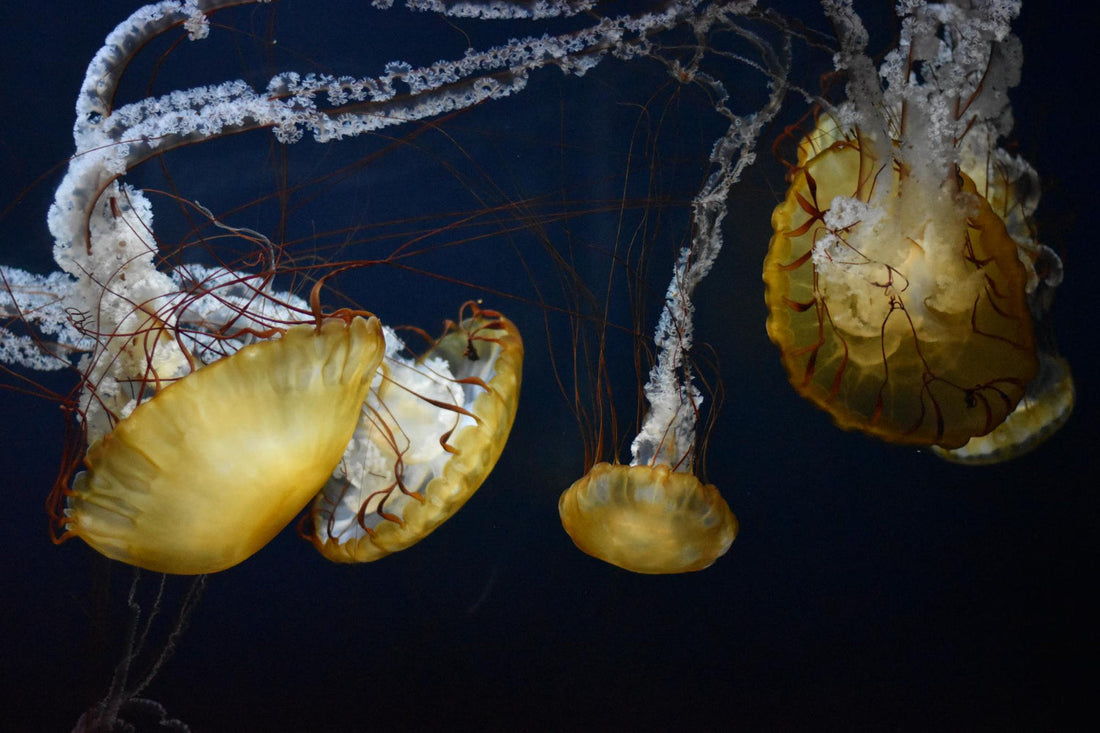
Did you know that the jellyfish is the longest-lived animal on earth? Its appearance dates back more than 700 million years. Throughout time, biologists and renowned celebrities have been interested in discovering its many singularities. Paying special attention to their origin, danger and morphology. What makes us think that it is one of the most peculiar species of the underwater world. These are the 10 characteristics of the most special jellyfish.
The oddities of this marine animal become more pronounced as we analyze its morphology. So much so that is the only known species that has survived the evolution of millions of years without fundamental organs such as a brain or a heart. Nor do they have a central nervous system as such.
You may ask: How do jellyfish think if they do not have a brain? They have a network of nerves located in the epidermis, which facilitates the detection of other organisms. The moment they feel and/or perceive a touch, this stimulus is transmitted along the network. In other words, this hierarchical neural network controls each and every one of their movements and decisions.
So that you can quickly visualize the concept: this neural network is actually a subdivision by zones or sections - like a pie or a pizza. Each of its tentacles is connected to one of those outer slices. And when they detect food, they catch it and the neurons in that zone are activated, sending messages to the inner section, which is where the mouth is located.
Characteristics of jellyfish: morphology and habitat
In addition to being the only animal without a brain or heart, jellyfish also have these other characteristics:
- They are composed of 95% water
They have no bone structure. They are soft and delicate, so they can be easily damaged. They require even more water to move and if they do not remain in their aquatic habitat, they collapse and die.
- They are radially symmetrical
These beings are symmetrical because of a central axis that runs through the length of their body. They have an upper and lower part, but no left or right sides. They are different from other types of animals (such as mammals, reptiles, fish, birds and arthropods) which exhibit bilateral symmetry.
- Your mouth also functions as an intestine
Their digestive system is extremely rustic, with a single, simple opening. These animals ingest food through their mouth, located in the lower part of their bell. The food is digested in a sac-like structure (called the coelenteron or gastrovascular cavity). Waste material is also expelled through the mouth. This cavity then functions in two ways: as a stomach and as an intestine.
- They move like jets
A common analogy used to describe how jellyfish move in water is the one that refers to their movement as "a simple form of jet propulsion". It takes in water inside its muscular bell and subsequently squirts it out, creating a jet of water that propels it forward. It also takes advantage of water currents to move.
- Can produce light
Despite having a very advanced anatomy, some jellyfish are able to emit light to attract prey or when they are in danger. They have a light protein on the back of their body; some use it to defend themselves and others to attack. The jellyfish Pelagia Noctiluca is the best known for its luminescent qualities. It inhabits all oceans, but tends to be found mainly in the Mediterranean Sea.
- They have 24 eyes around their body
They are almost as advanced as those of humans. While we have one pair of multipurpose eyes that detect color, shape, size and light intensity, cube jellyfish have four types of eyes with different purposes. The most primitive ones basically function as light/dark detectors to guide their navigation, and are the ones that all other jellyfish have. The two most advanced ones detect shape and serve to keep them within the safe territory provided by the underwater vegetation. The rest of the primitive eyes have them around the body as if forming a belt.
- No respiratory system
Oxygen diffusion occurs at the tissue level. They also do not have a circulatory or excretory system.
- Its body is made up of three layers
The very strange body of every jellyfish has only 3 layers. The outer layer is called the epidermis and the inner layer is called the gastrodermis. In between, there is a thick substance called mesoglea.
- They live in both salt and fresh water.
The species CraspedacustaSowerbyi is the only species of freshwater jellyfish.
- Its tentacles are made up of thousands of stinging cells.
Among the most peculiar characteristics of jellyfish is their stinging capacity. There are thousands of nematocysts in their tentacles, arms and mouth. The nematocysts consist of a capsule containing a stinger, a venom sac and chemo-sensitive hairs that allow them to detect food. When a potential prey touches these hairs, the nematocysts expel and inject the venom into the victim. The venom immobilizes the prey and the jellyfish uses its arms to pull the prey into its mouth.
So far these are the main characteristics of jellyfish. If you are interested in knowing them in more detail, you can visit our species section. We explain their classification, habitat, danger and morphology.
If you liked discovering these curiosities about jellyfish, pay attention: you will surely be surprised to know that you can avoid jellyfish stings with our anti jellyfish sun creams for adults, children, babies and/or athletes.
How to avoid jellyfish stings
Our sunscreens also act as an anti jellyfish cream. They protect the skin in contact with jellyfish and prevent their sting. Safe Sea is not a jellyfish repellent.
The ingredients in a repellent keep the insects or animals in question away from our skin. Humans generally attract insects, ticks and other arthropods by the simple act of emanating heat and sweat. Perfumes and creams also help attract the attention of these animals.
To prevent these animals from remaining on our skin long enough to give the "peck", the repellent forms a barrier on the surface of our dermis. This is achieved thanks to specific active ingredients, such as DEET (N,N-Diethyl-m-toluamide), a chemical compound that confuses animal receptors and interferes with their perception of environmental odors.
The result is a kind of disorientation, as they do not know exactly where to bite. The duration of this protection varies according to the concentration of DEET used in the repellent formula.
If we are not a jellyfish repellent: how can we classify our product?
Safe Sea is an inhibitor.
It contains in its formula exclusive and patented ingredients, which block the sensory cells of the tentacles, just at the moment when the burning/stinging process is activated. In other words, jellyfish do come into contact with our skin, but they do not detect us as intimidation or prey.
We must keep in mind that the venom released during contact with live water is nothing more than a natural defense mechanism for the animal, which is only activated whenever it feels threatened. Therefore, if there is no identification of threat, the sting does not occur.








